In Melbourne's thriving business ecosystem, where innovation intersects with economic pressures, mobile apps have become indispensable for customer engagement, operational streamlining, and maintaining a competitive edge. With over 80% of Australians accessing services via mobile devices, the demand for robust, scalable apps is at an all-time high. Yet, traditional native development methods—requiring separate codebases for iOS and Android—often lead to inflated budgets and prolonged timelines. Enter React Native: a framework that's evolving from a cost-cutting tool to a strategic imperative for forward-thinking executives.
Developed by Meta, React Native enables developers to build high-performance mobile apps using a single JavaScript codebase that deploys seamlessly across both platforms. In 2025, its adoption in Australia has surged, with cross-platform frameworks like React Native powering over 33% of new apps, up from 12% in previous years. Melbourne, as a key innovation hub alongside Sydney, is at the forefront of this shift, with local firms in e-commerce, healthcare, and fintech leveraging it for efficiency and scalability. This blog, structured around the Pain-Agitate-Solution framework, delves into the challenges of app development, amplifies their impacts, and presents React Native—delivered through C9, Australia's leading custom software, apps, integration, and database developer—as the optimal solution. Tailored for Melbourne-based business owners and executives, we'll explore trends, facts, and practical insights to help you make informed decisions on React Native app development in Melbourne.
The Real Challenges Melbourne Businesses Face in App Development
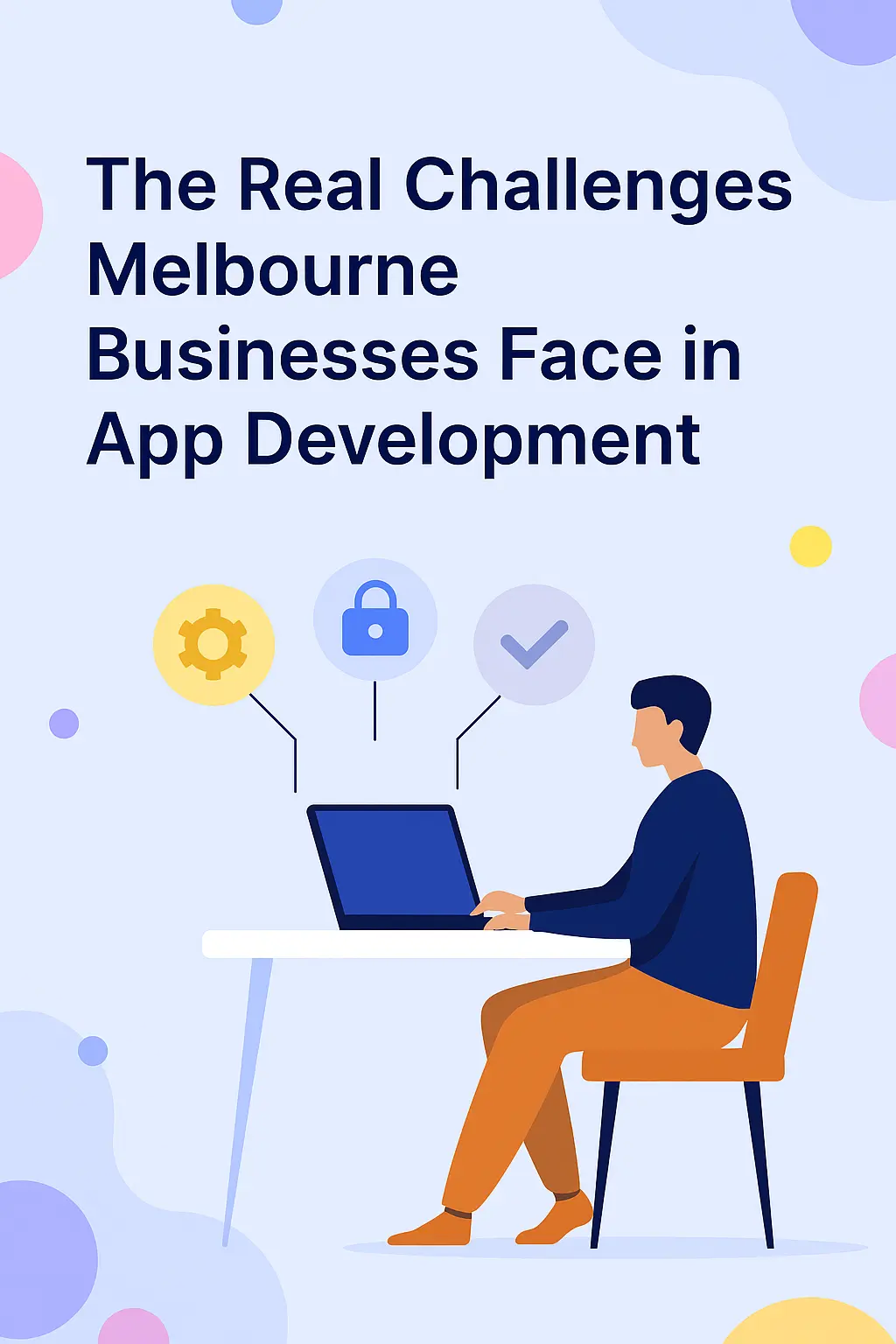
As a Melbourne executive, you're likely familiar with the relentless pace of Australia's digital economy, projected to contribute AUD 176.88 billion from mobile apps by 2030. However, pursuing mobile solutions often uncovers significant hurdles. Traditional native app development demands duplicated efforts: separate teams for iOS (using Swift/Objective-C) and Android (using Kotlin/Java), dual codebases, and parallel testing regimes. This redundancy not only escalates costs—averaging AUD 30,000 to AUD 300,000 per app in Australia—but also stretches timelines, with complex projects taking 5-6 months or more.
Consider the financial strain: developer rates in Melbourne range from AUD 100 to AUD 200 per hour, and maintaining specialised talent for each platform can inflate budgets by 40-50%. For a mid-sized e-commerce business, this might mean diverting AUD 150,000+ from marketing or expansion just to get an app off the ground. Time delays are equally painful; in a market where 90% of users expect seamless mobile experiences, slow rollouts result in missed opportunities, such as capitalising on seasonal events like Melbourne's spring racing carnival or end-of-year sales.
Security and maintenance add layers of complexity. Managing two platforms increases vulnerability risks, with updates needing to be applied twice, leading to higher ongoing costs—often 20-30% of the initial budget annually. For analytical executives, these inefficiencies manifest as frustration: why endure redundant processes when your focus should be on driving ROI, fostering innovation, and scaling operations in a smartphone-saturated environment where 80% of business interactions occur via mobile?
Why These Challenges Are Costing You More Than You Realise
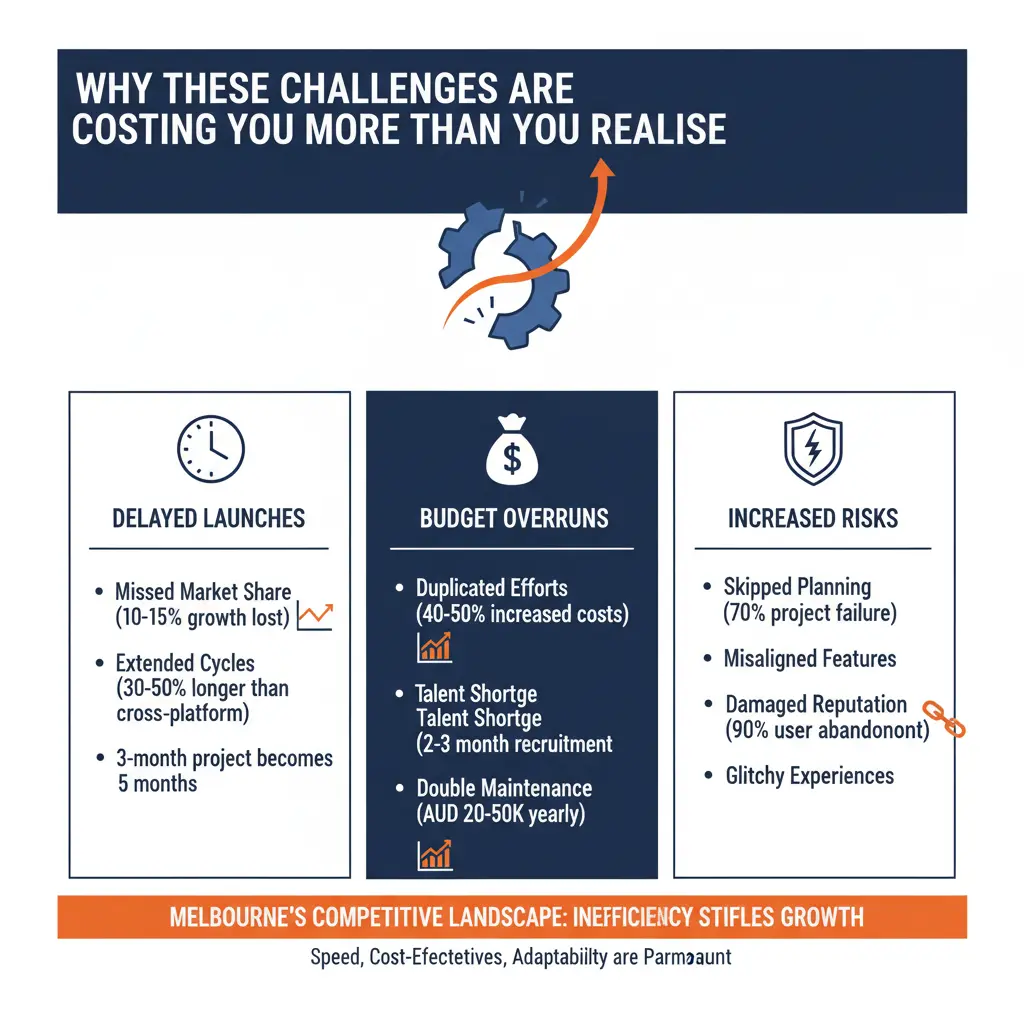
The pains of conventional app development aren't mere inconveniences—they can undermine your entire business strategy in Melbourne's competitive landscape. Delays in launching an app could mean forfeiting market share to agile competitors; for instance, a fintech firm missing a key regulatory window might lose thousands in potential revenue, with Australia's mobile app market growing at 10-15% annually. Native development's extended cycles—often 30-50% longer than cross-platform alternatives—exacerbate this, turning what should be a 3-month project into a 5-month ordeal.
Budget overruns are rampant. Duplicated efforts can balloon costs by 40-50%, transforming an estimated AUD 100,000 investment into AUD 150,000 or more due to scope creep, revisions, and unforeseen integrations. Melbourne's talent shortage intensifies this, with demand for skilled developers pushing rates higher and prolonging recruitment—up to 2-3 months for specialised roles. Without a unified framework, maintenance becomes a perpetual drain: separate iOS and Android updates double expenses, potentially adding AUD 20,000-50,000 yearly for a medium-complexity app.
Skipping critical planning steps, like discovery calls, heightens risks further. Rushing into development without defined requirements leads to misaligned features, rework, and failure rates as high as 70% for software projects. This not only strains finances but damages reputation: a subpar app can erode customer trust, with 90% of users abandoning glitchy experiences. In Melbourne's innovation-driven economy, these issues create a cycle of inefficiency, stifling growth and leaving businesses vulnerable in an era where speed, cost-effectiveness, and adaptability are paramount.
Embracing React Native with C9 for Strategic Efficiency
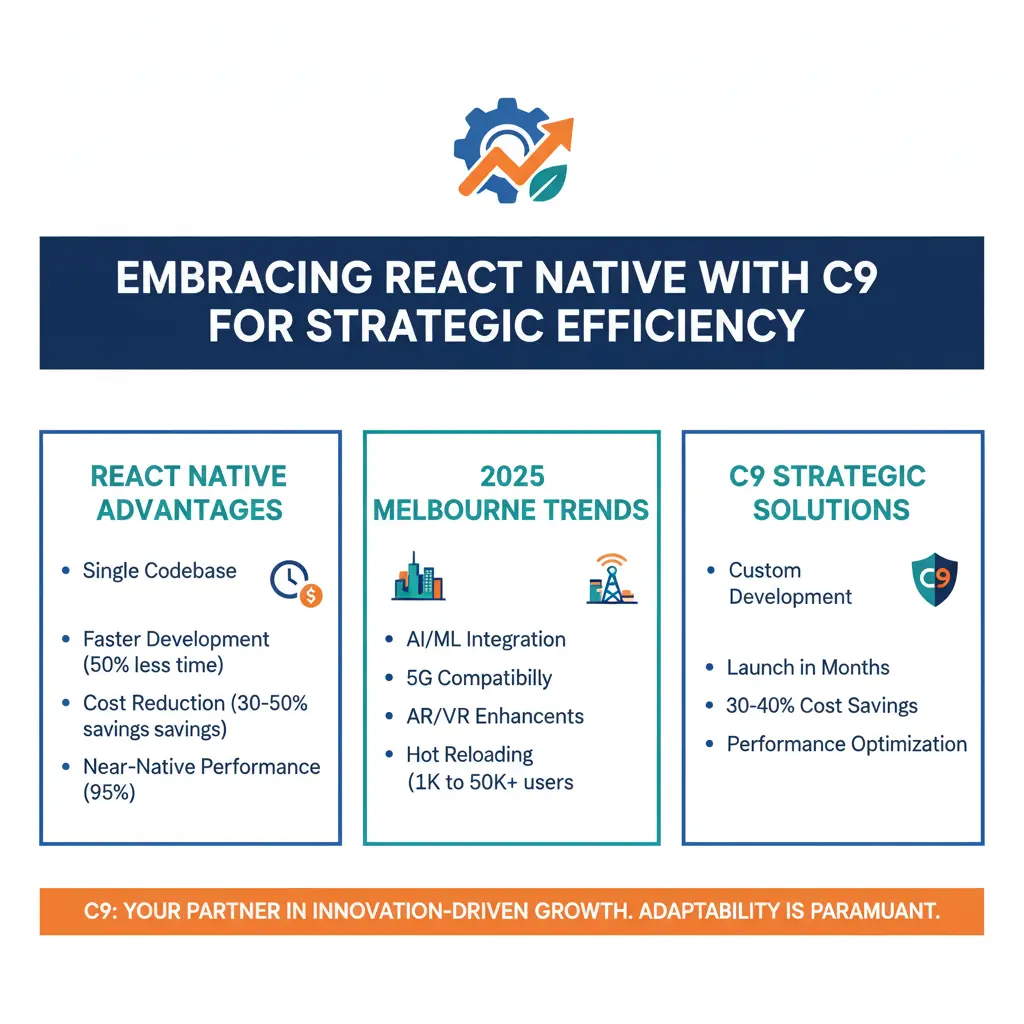
React Native offers a compelling antidote to these challenges, positioning itself as the leading cross-platform framework in 2025. By enabling a single codebase for iOS and Android, it delivers near-native performance—achieving up to 95% in benchmarks—while reducing development time by up to 50% and costs by 30-50% compared to native approaches. No longer just a "budget" option, it's a strategic choice, with React Native powering 30% of top iOS apps and ranking second on Google Play for non-native frameworks.
In Melbourne, adoption is accelerating amid 2025 trends like AI/ML integration (e.g., TensorFlow for predictive features), 5G compatibility for real-time apps, and AR/VR enhancements for immersive experiences in retail and education. Businesses benefit from hot reloading for instant iterations, an extensive ecosystem of pre-built components, and scalability for handling user growth from 1,000 to 50,000+ without major overhauls. For example, a Melbourne education provider achieved 99.9% uptime with a React Native app featuring offline access and smooth animations.
At C9, we specialise in React Native app development in Melbourne, delivering custom solutions that align with your strategic goals. Our projects have enabled clients to launch in 3 months versus 5, yielding 30-40% savings reinvested into growth. We emphasise performance optimisation, TypeScript adoption for robust code, and server-side rendering (SSR) for faster loads—key trends shaping 2025.
The Power of Discovery Calls: Why They're Essential and How They Work
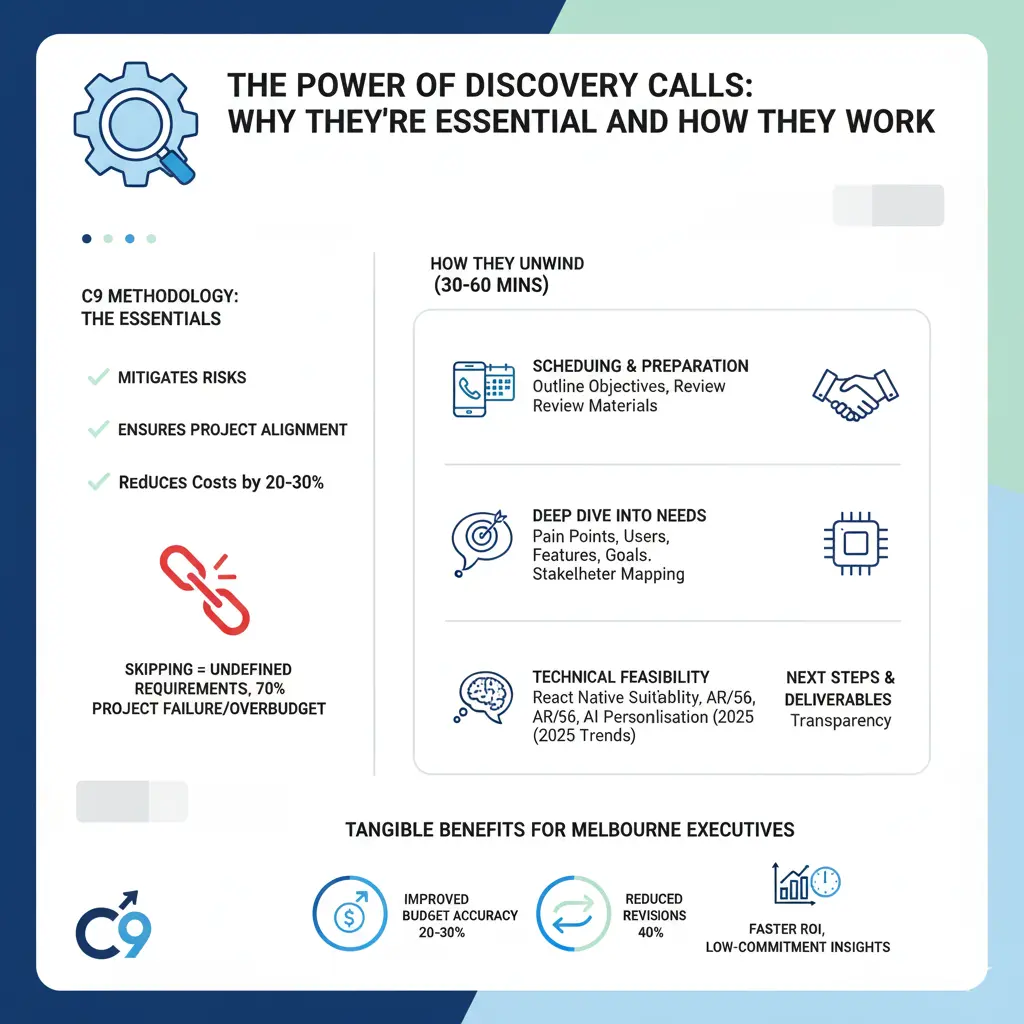
Central to C9's methodology is the discovery call—a foundational session that mitigates risks and ensures project alignment. Skipping it is among the worst decisions in software development, as it often results in undefined requirements, leading to 70% of projects overrunning budgets or failing outright. The discovery phase reduces costs by 20-30% through early risk identification and precise scoping, transforming assumptions into actionable plans.
Here's how discovery calls unfold at C9, typically lasting 30-60 minutes and providing immediate value:
- Scheduling and Preparation (5-10 Minutes): We arrange a call via phone or video, where you outline high-level objectives. We review any provided materials to maximise efficiency.
- Deep Dive into Needs (20-30 Minutes): Targeted questions explore pain points, target users, must-have features, integrations, and business goals. This uses tools like stakeholder mapping to differentiate essentials from enhancements.
- Technical Feasibility Assessment (10-15 Minutes): We evaluate React Native's suitability, addressing challenges like AR integrations or 5G requirements, and align with 2025 trends such as AI-driven personalisation.
- Next Steps and Deliverables (5 Minutes): A summarised roadmap is provided, including staged timelines and potential risks, fostering transparency.
Far from a time-waster, these calls deliver tangible benefits: improved budget accuracy by 20-30%, reduced revisions by 40%, and faster ROI. For Melbourne executives, it's a low-commitment gateway to insights, building trust without obligation.
Breaking Projects into Stages for Early ROI
C9 advocates staging React Native projects to accelerate value delivery. Starting with a Minimum Viable Product (MVP) allows core features to launch swiftly, generating early ROI that funds subsequent phases. This modular approach minimises risks, incorporates user feedback, and adapts to market shifts—crucial in Melbourne's dynamic sectors.
For instance, a retail client began with an MVP e-commerce app (Stage 1: AUD 50,000, 2 months), achieving a 25% sales increase. Savings were reinvested into Stage 2 for AI recommendations, enhancing engagement by 35%. This strategy aligns with 2025 best practices, where 70% of enterprises favour iterative development for scalability.
Navigating Pricing: The Pitfalls of Indicative Quotes vs. Discovery-Based Precision
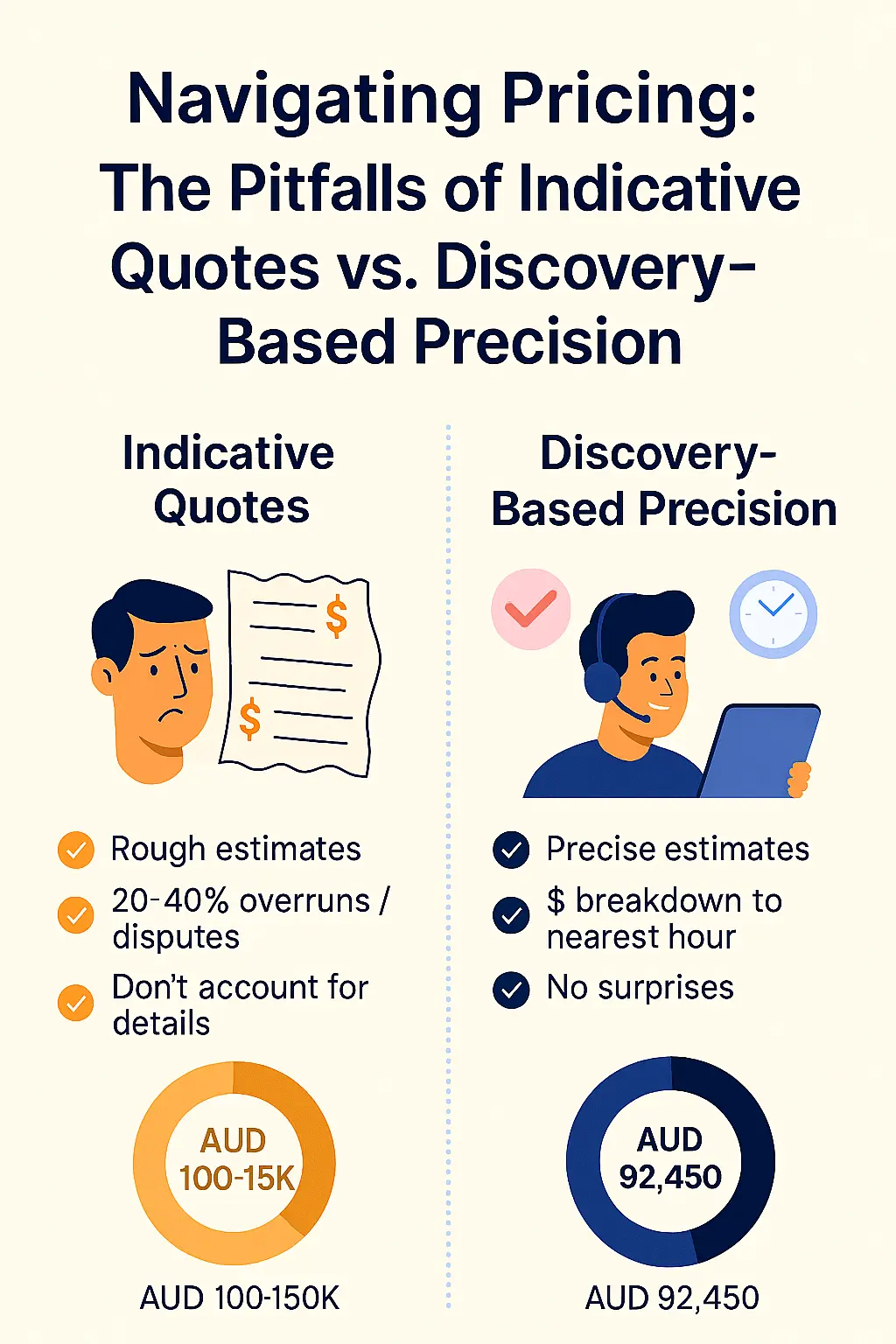
Pricing transparency is vital for Melbourne executives, yet indicative quotes—rough estimates based on assumptions—harbour significant pitfalls. Often rounded to the nearest day or week, they overlook nuances, leading to overruns of 20-40% and disputes. For a React Native app, an indicative range of AUD 100,000-150,000 might ignore integrations, ballooning to AUD 200,000+. Such quotes aren't worth the paper they're written on, as they fail to account for specifics, fostering inefficiency and eroding trust—50% of projects exceed them due to hidden complexities.
Conversely, C9's discovery-based pricing offers precision to the nearest hour, grounded in detailed requirements post-call. We break costs transparently: e.g., UI/UX design (20 hours at AUD 150/hr = AUD 3,000), core development (200 hours = AUD 30,000), testing (50 hours = AUD 7,500), totalling AUD 40,500 for an MVP. This contrasts with an indicative "AUD 30,000-50,000" (nearest week: 3-5 weeks at AUD 10,000/week), providing accuracy and avoiding surprises.
A real-world example: A Melbourne fintech executive requested a customer onboarding app. A competitor's indicative quote was AUD 80,000 (nearest week, assuming basics). After discovery, its been refined for API integrations, pricing at AUD 92,450 (precise: 615 hours at AUD 150/hr, staged as MVP at 300 hours/AUD 45,000, then enhancements). Early MVP ROI covered savings for Stage 2, demonstrating discovery's value in preventing waste.
Insist on discovery before pricing; it ensures staged projects yield incremental wins, turning development into a strategic investment.
Secure Your Competitive Edge with React Native and C9
Melbourne businesses are embracing React Native for its efficiency, cost savings, and alignment with 2025 trends like AI and 5G. By addressing pains through C9's expertise, you can achieve faster, scalable growth. Don't let outdated methods hinder progress—the future is cross-platform.
Ready for React Native app development in Melbourne? Book a free discovery call with C9 today at www.c9.com.au . Gain insights tailored to your needs—no commitments, just value.
Table of React Native Benefits for Melbourne Businesses in 2025
| Benefit |
Description |
Impact on Business |
Supporting Fact/Stat |
| Cost Savings |
Single codebase reduces duplication |
30-50% lower development costs |
Up to AUD 100,000 saved on medium apps |
| Time Efficiency |
Hot reloading and reusable components |
Up to 50% faster launches |
3 months vs. 5 for native |
| Performance |
Near-native speed with optimisations |
Scalable for high-traffic apps |
95% benchmark parity |
| Scalability |
Handles user growth seamlessly |
Supports enterprise expansion |
Powers 30% of top iOS apps |
| Trend Integration |
AI, 5G, AR compatibility |
Future-proof solutions |
Key for 2025 immersive tech |
Table of App Development Cost Breakdown in Australia (2025)
| Complexity Level |
Cost Range (AUD) |
Features Included |
Timeline |
| Simple |
30,000-70,000 |
Basic UI, authentication, API integration |
1-2 months |
| Medium |
70,000-150,000 |
Real-time features, databases, push notifications |
3-4 months |
| Complex |
150,000-300,000+ |
AI/ML, AR/VR, custom integrations |
5+ months |
Key Citations